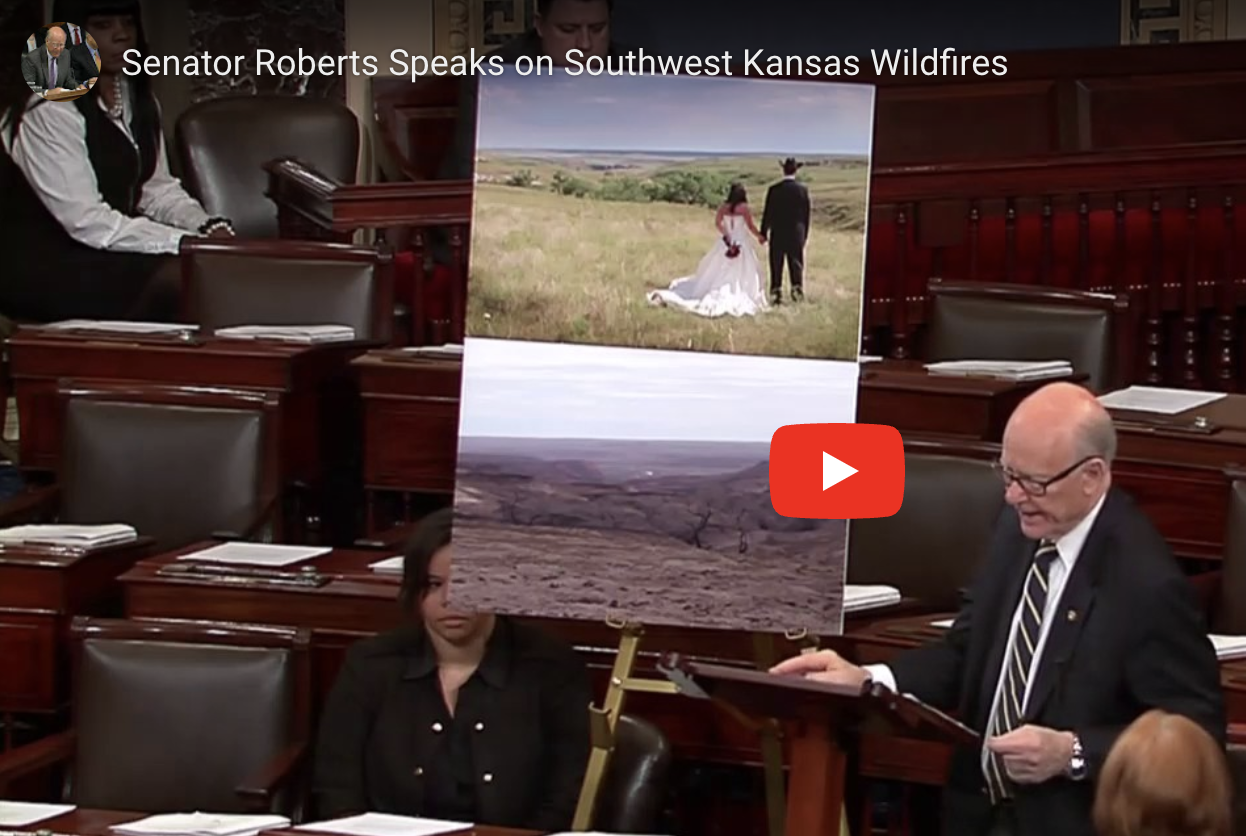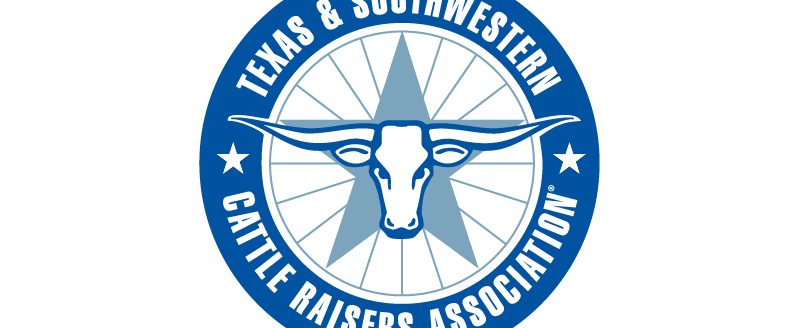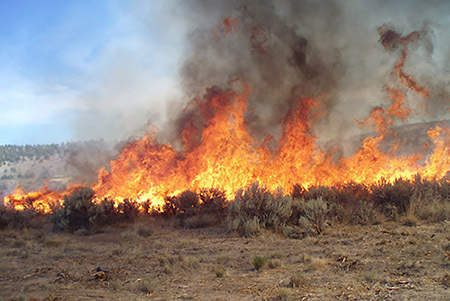Senator Roberts Speaks on Southwest Kansas Wildfires

Madam President, I rise today to speak about the historical and unprecedented wildfires that burned through southwest Kansas last week. We had fires in 21 of Arkansas counties, which runs roughly one-fifth of our state. High winds and dry conditions caused fires of the highest classification to blaze across central and western Kansas, some 30 to 40 feet high, burning more than 700,000 acres of land, making this the largest wildfire in our state’s history. The Kansas Division of Emergency Management has said it could take weeks to determine the full extent of devastation from the fires. Clark County, Kansas officials (that’s the county that was the hardest hit) estimate a devastating loss of anywhere from 3,000 to 9,000 head of cattle, that’s just 11 County.
As I indicated, Clark County was the hardest hit by the windblown fires, with over eighty-five percent of the land in the county consumed by these prairie fires. It’s as hundreds of thousands of acres in one County, over 700,000 in regards to our state.
On Friday, I drove south from Dodge City, Kansas, through range and ranch land. I didn’t even recognize what used to be gently rolling prairie dotted with herds of cattle and crisscrossed by fencing. It’s now reduced to black and dust. Friends of mine lost their ranch when a 40-foot wall of fire roared out of the valley over the bluff and burned out their operation. We have unmanageable damage to land and property, but also heart-wrenching scenes of cattle and wildlife burned, wounded, and wandering. Many Kansans lost everything. According to Sheriff John Catrin, Clark County, 31 houses and over 440,000 acres were burned.
We have a long-time friends there, John and Carol Swayze. We’ve known him for years. John said to me with tears in his eyes, “Pat, it took me forty-three years to build up this operation and it took about an hour to take it all down.” Riding with Sheriff Ketron, we were assessing the town of Ashland, where a volunteer firefighting force managed to save the town when it became surrounded in flames. Some volunteers were fighting fires elsewhere in the area and learned their own homes had been engulfed and lost.
I met with brave people in the towns of Inglewood in Ashland and Candace, in the heart of Clark County, who had just come through frightening experiences fighting the unpredictable and unstoppable fires. Some are out driving cattle away from the fires and had become separated from loved ones when the flames turned. They were left to pray for their safety. Kalene Scott, with the High Plains Journal, calls it the worst day of her life, and she wrote a courageous and honest account of the day. “I read her words now. I think I had them going the right way, and then the winds switched. Now, I just don’t know. When I heard the crack and my husband’s voice yesterday afternoon, I knew it was bad. He’s normally the calm, cool, and collected one. A family friend alerted him to the fire in Clark County very near the Scott farm. After we’d returned home from burying my dad yesterday, coming back from the funeral, when they said the closest neighbor was being evacuated, he went as quickly as he could, herding for the cattle herd he worked for the last five years to build, following the death of his own dad. I stayed behind with the boys at our house that’s 40 miles away. When the wind switched at my house from south-southwest to the north, I began to worry even more. In a call to at this point, it was waiting out the fire and smoke in the wheat field, helplessly watching the house and the barn burned. I wanted to be at the farm so bad, but there wasn’t much that could be done. When he made it home unscathed, I was pretty happy, but sad at the same time, knowing there was nothing we could do to fix what it took Mother Nature mere minutes to destroy. 52 cows are on the farm, with about half or three fourths of them with young calves. Most are accounted for. All the grass is gone, as is the hay stockpile. He went to old water to the cows this morning, and some are scorched and others have cutters with burns. One cow’s bawling/missing calf. ‘Those poor mamas,’ was my text reply to him.
As of this morning, I made my way early this afternoon to see the farm or what’s left of it with my own eyes. As bad as I wanted to be down there, at Lisa, me dreaded the drive. The closer I got to the farm, the worse it got: blowing dirt, darkening skies because of the dust, and the awful winds. I pulled in the drive like I’d done a hundred times. Nearly 20 years I have been part of the family, and I had to stop my vehicle. The tears came and the heartbreak overwhelming. I thought of the old white farmhouse with a wonderful front porch where my husband spent a large majority of his childhood. My fondest memory is when we’d stop and see my husband’s grandma Pauline. She always had something sweet to eat and a cold drink at the kitchen table. The home had been around for 100 years and still had a large portion of the family’s mementos in it. It was reduced to ashes and rubble. All that is standing is the chimney. I couldn’t see the barn around the trees, but I again had to stop and said, when I pulled around the corner, the barn, the old barn with its red siding. I remember when my father-in-law had it painted how proud he was because it looked good. I remember when he laid the brick in front of the tack room and built a new door. My boys explored every inch of it when we worked calves last fall. You could almost hear the horses munching in the stalls decades ago when you stood in the center alley. Now it’s just a charred pile of tin. I realized the house and barn are just buildings. Things can be replaced, but dang it’s so hard to see it all reduced to ashes and rubble. To see part of the Scott family history, more than a hundred years, just be gone just like that. It’s hard.
We’ve had an incredible friends and family offering help, hay, and feed, and it’s heartwarming to know how much people care. Like I heard in Ashland, Kansas, a resident on the news this morning being interviewed, “It’s just what southwest Kansas people do: help and survive.”
Here’s the picture. It was taken on Kalene and Spencer Scott’s wedding day. Right up here, it’s a beautiful sight. Out there in the distance is the Clark County lake. It’s rolling hills, cattle country, cattle, and grass. Looking at this picture now, it’s not hard to wonder how this land will come back to provide for so many, as it has for generations of Kansas farms and ranch families whose sweat and blood have produced for Kansas, our nation, and yes, the world as well. There’s the other picture. They got married here, happiest day of their life. Saw this, and it became just about the worst day of their life.
And yet, having seen this devastation firsthand, I don’t wonder about Kansas and our ability to rebuild. It is in our state motto, “Ad Astra per Aspera” — to the stars through difficulties. In one of the emergency management centers, I met Joyce. Joyce, heading her, and when I asked her what I could do to help, she just said, “The Lord will provide.” She had lost virtually everything. I think that pretty well sums it up. The faith of Kansans gives us courage to rebuild, the courage to come through.
Ashland banker, Kendall K., emotionally said, “Senator, we’re going to need help. We really don’t want it, but we are going to need it.” I am so proud of the people of my state who have come in without help before they even asked. I have been in contact with all of our producer groups in Kansas, the Kansas Livestock Association, the Kansas Farm Bureau, who along with our state agencies, have been leading the voluntary relief effort. I commend them for their efforts in collecting hay for cattle, as well as monetary donations coming in from all parts of the United States and volunteer coordination for repairs to property and fencing.
Now, Congressman Roger Marshall of the 1st Congressional District and my colleague here and friend in the Senate, Jerry Moran, we’ve been in touch with the Department of Agriculture with regards to assistance that should be available to farmers and ranchers in counties that have suffered loss.
Here’s what we’re trying to fix: this fella walking across here to that bluff that overlooks that valley that Spencer and Kalene looked over, and this fella here is Chad Tenpenny, who is my top gun in Kansas. That’s me with my hands in my pockets. It’s pretty rough to see, you know, ground like this. There was grass, and look at the utter devastation, folks. When that wind blows and that dust starts up again, we could be in even more trouble. So cleanup as other what underway, but we’re trying to get help, cut through the red tape, and get a disaster declaration. I talked to the governor this afternoon, and primarily it’s the Emergency Conservation Program, the Livestock Indemnity Program, Equipped. That’s the key program. The Environmental Quality Incentives Program. This will make people hold by any means, but it will give them hope.
So cleanup is underway. Kansas is a bootstrap state. It’s just not about building new fencing. We have families who have lost the farmhouse and all of the equipment they need to rebuild. Many livestock producers have had the gruesome task of euthanizing cattle that have been badly burned. We have to remove the carcasses. We have to find land for the survivors to graze, and we have a lot of uncertainty. How long will it take for the grasses to come back? When can we get rain to avoid a dust bowl? It’s really too soon to tell, but we have been through disasters before. Almost one year ago, we had the Anderson Creek fire, and we have come through tornadoes and ice storms. Recovery from disasters of this magnitude, however, requires us to cut through the red tape. It requires getting the right information to producers so they know how to apply for aid and then to expedite, and yes, it requires us to look at our programs to see where we can improve them.
This fire has not received much attention in the national media. You see, we’re a flyover state. All we do is produce food and fiber for Kansas and our nation and for a troubled and hungry world. But I do want to commend members of the press in Kansas, especially photographer Bull Rider of the Wichita Eagle, who took this photo. Chad, myself, walking through range land outside of Ashland. The Wichita Eagle has gone out of their way to show the world what this fire looks like to real people. The Hutchinson News, the High Plains Journal, and the Dodge City Globe are telling this story. The same is true for the TV and radio crews who get the news of town evacuation, the safety notices to our people. This is what they do.
Rest assured, as chairman of the Senate Agriculture Committee, I am committed to the Kansans I serve. They know me. I know them. I know Clark County and the other 20 counties will come back. We will ensure they get the help that they need. Ad Astra per Aspera, to the stars through difficulty. Madam President, it’s just not a model. It’s who we are. I yield back.



